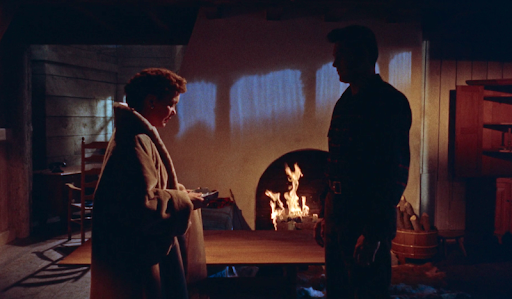While I personally am not too crazy about All That Heaven Allows, I do admire just how straightforward its editing is as the narrative develops. From what I can tell, Sirk utilizes continuity editing for majority of the movie to achieve great effects on the viewer.
If there is one thing that continuity editing does for this movie, it’s making sure that the reader is never confused. I mean, this movie is textbook! For instance, let’s take a look at Sirk’s repeated use of establishing shots. We can tell what type of town this is from the first shot of the film, which slowly pans left in a high-angle long shot that overlooks a picturesque suburb as dreamy non-diagetic music plays. The town’s “too good to be true” aesthetic combined with external sound exudes an air of superficiality that we expectedly see reflected in its inhabitants through their interactions with Cary. If perhaps that particular establishing shot may have not been clear enough, then Sirk’s establishing shots that include signs will definitely paint the picture of the setting for you.

That’s just the magic of this movie: to keep the viewer enveloped in the melodrama by making on screen setting, movement, and dialogue so clear. Whether it be due to the use of the match-on-action shot that keeps Cary’s movements consistent during parties or the reverse shots on the axis of action during Cary and Ron’s dialogue, we are constantly sure of where a character is heading or which character is talking. Another major factor that contributes to the viewer’s awareness is the excellent execution of eye-line match between shots. I do not think it’s possible to misinterpret where a character is looking in a given shot throughout the movie. There’s countless other factors I could talk about (tracking shots capturing Cary’s movement that simultaneously establishing a setting, fade-outs and fade-ins between shots that convey the passage of time, the sequence of an establishing shot to a medium or close-up shot that expresses intimacy between characters, etc.), but I would also love to talk about what exactly the continuity editing let’s us focus on!

The mise-en-scene, particularly the costuming, was very enjoyable in this movie! I loved how Cary’s grey costuming reflected her loneliness and the Ron’s brazen-red costuming complemented his confidence. A cool detail I noticed was that during the shot where Cary is shown crying through a window on a snowy night, her pajamas actually have the same red color and flannel pattern that we associate with Ron, subtly implying that he is the source of her sadness. Despite my bias toward costuming, however, it is clear that lighting is All That Heaven Allow‘s biggest strength in regard to mise-en-scene. The contrast between the the low-key lighting when Cary is alone and the high-key lighting when Cary talks to Ron during the beginning not only gives hint to Cary’s loneliness, but also shows just how happy Ron makes her. When in times of crisis, such as when Cary and Ron are uncertain about their future following the calling-off of the marriage, the introduction of low-key lighting in medium shots between the two allows the viewer to infer the loneliness that both Cary and Ron are feeling. Some of the most memorable shots owe themselves to the changing of emotion implied my the lighting.

In addition to the specifics of mise-en-scene, the use of continuity editing also let’s us hone in on other thingsm such as the film’s motifs. Whether it be the recurrent use of mirrors to reflect Cary’s emotional statement or the silver-tip spruce tree functioning as a symbol for Ron, the viewer is better equipped to notice it when they are not constantly having to worry about inconsistencies in the way the film is presented. All That Heaven Allows is truly a masterpiece in continuity editing, and shows why exactly it is so powerful in the development of a narrative as the viewer navigates settings, dialogue, and character interactions.

Hi Jaime. When I first read your blog title, I thought you were going to discuss the straightforwardness of “All That Heaven Allows'” plot. I found it to be a simple yet profound commentary on the way overvaluing perception can make you feel like an outsider in your own life. Cary is guilty of this throughout the whole film, and it is really unfortunate to see how country club gossip informs her life choices.
However, when I finished reading, I came to appreciate your interpretation (which greatly enhanced my own) of the ways continuity editing was essential in establishing the upper class, sophisticated lifestyle that Cary leads. The contrast between her world and Ron’s world was immediately apparent. Not to mention, I especially enjoyed your takes on the mise-en-scene costuming and lighting. Yes, Cary runs in an elite social circle, but she infrequently engages in posh festivities (and when she does, she clearly resents it and, therefore, does not care to blend in/put on a fake smile—a humanity that enamors a lot of men). Her colorless clothing choices, more soft spoken nature, and the fact that the lighting is dimmer in her intimate and emotionally-charged scenes with Ron than it is at said festivities, all suggest that she is lonely and misunderstood. Well done!!